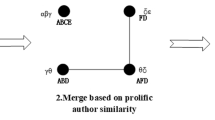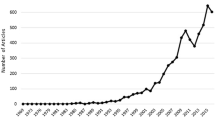Abstract
Emerging cyber-infrastructure tools are enabling scientists to transparently co-develop, share, and communicate about real-time diverse forms of knowledge artifacts. In these environments, communication preferences of scientists are posited as an important factor affecting innovation capacity and robustness of social and knowledge network structures. Scientific knowledge creation in such communities is called global participatory science (GPS). Recently, using agent-based modeling and collective action theory as a basis, a complex adaptive social communication network model (CollectiveInnoSim) is implemented. This work leverages CollectiveInnoSim implementing communication preferences of scientists. Social network metrics and knowledge production patterns are used as proxy metrics to infer innovation potential of emergent knowledge and collaboration networks. The objective is to present the underlying communication dynamics of GPS in a form of computational model and delineate the impacts of various communication preferences of scientists on innovation potential of the collaboration network. Gained insight can ultimately help policy-makers to design GPS environments and promote innovation.



















Similar content being viewed by others
Notes
NSF/SRS Workshop on Advancing Measures of Innovations: Knowledge Flows, Business Metrics, and Measurement Strategies, 2006.
http://scienceofsciencepolicy.net—as of 08 February 2016.
http://www.nae.edu—as of 08 February 2016.
http://faculty.ucr.edu/~hanneman/soc157/18_Homophily.html—as of 08 February 2016.
References
Albert R, Barabási A (2002) Statistical mechanics of complex networks. Rev Mod Phys 74(1):47
Becker G (1978) The economic approach to human behavior. The University of Chicago Press, Chicago
Benhamou F, Peltier S (2010) Application of the Stirling model to assess diversity using UIS cinema data. UNESCO Institute for Statistics, Montreal, pp 1–73
Borgatti S, Everett M (2000) Models of core/periphery structures. Soc Netw 21(4):375–395
Boyd J, Fitzgerald W, Beck R (2006) Computing core/periphery structures and permutation tests for social relations data. Soc Netw 28(2):165–178
Burt R (1995) Structural holes: the social structure of competition. Harvard University Press, Cambridge
Finholt T, Olson G (1997) From laboratories to collaboratories: a new organizational form for scientific collaboration. Psychol Sci 8(1):28
Hollingshead AB, Fulk J, Monge P (2002) Fostering intranet knowledge sharing: an integration of transactive memory and public goods approaches. In: Distributed work. MIT Press, Cambridge, pp 335–355
Krebs V, Holley J (2002) Building sustainable communities through network building. http://www.orgnet.com/BuildingNetworks.pdf. Accessed 2 Aug 2016
Monge P, Contractor N (2003) Theories of communication networks. Oxford University Press, New York
Newman M (2010) Networks: an introduction. Oxford University Press, Oxford
Nielsen M (2010) The logic of collective action. http://michaelnielsen.org/blog/the-logic-of-collective-action/. Accessed 2 Aug 2016
North MJ, Collier NT, Ozik J, Tatara ER, Macal CM, Bragen M, Sydelko P (2013) Complex adaptive systems modeling with Repast Simphony. Complex Adapt Syst Model 1(1):1–26
Olson M (1974) The logic of collective action: public goods and the theory of groups. Harvard University Press, Cambridge
O’Mahony S, Ferraro F (2007) The emergence of governance in an open source community. Acad Manag J 50(5):1079–1106
Ostrom E, Hess C (2007) Understanding knowledge as a commons: from theory to practice. MIT Press, Cambridge
Ozmen O (2013) Exploring the impact of socio-technical communication styles on the robustness and innovation potential of global participatory science. PhD Thesis, Auburn University
Page S (2010) Diversity and complexity. Princeton University Press, Princeton
Pirolli P, Card S (1999) Information foraging. Psychol Rev 106(4):643
Rafols I, Meyer M (2010) Diversity and network coherence as indicators of interdisciplinarity: case studies in bionanoscience. Scientometrics 82(2):263–287
Rowley T (1997) Moving beyond dyadic ties: a network theory of stakeholder influences. Acad Manag Rev 22(4):887–910
Shlesinger MF (2007) Complex adaptive systems: an introduction to computational models of social life. J Stat Phys 129(2):409–410
Bharathy GK, Silverman B (2010) Validating agent based social systems models. In Proceedings of the winter simulation conference. Winter Simulation Conference, pp 441–453
Stirling A (2007) A general framework for analysing diversity in science, technology and society. J R Soc Interface 4(15):707–719
Uzzi B, Spiro J (2005) Collaboration and creativity: the small world problem. AJS 111(2):447–504
Wagner C (2008) The new invisible college: science for development. Brookings Institution Press, Washington, DC
Wasserman S (1994) Social network analysis: methods and applications. Cambridge University Press, New York
Wynn D (2003) Organizational structure of open source projects: a life cycle approach. In: 7th Annual conference of the Southern Association for Information Systems, Georgia
Zou G, Yilmaz L (2011) Dynamics of knowledge creation in global participatory science communities: open innovation communities from a network perspective. Comput Math Organ Theory 17(1):35–58
Acknowledgments
This manuscript has been authored by UT-Battelle, LLC under Contract No. DE-AC05-00OR22725 with the U.S. Department of Energy. The United States Government retains and the publisher, by accepting the article for publication, acknowledges that the United States Government retains a non-exclusive, paid-up, irrevocable, world-wide license to publish or reproduce the published form of this manuscript, or allow others to do so, for United States Government purposes. The Department of Energy will provide public access to these results of federally sponsored research in accordance with the DOE Public Access Plan (http://energy.gov/downloads/doe-public-access-plan). This research is also partially supported by National Science Foundation (NSF) as authorized by the contract number NSF-SBE-0830261 and Industrial and Systems Engineering Department assistantships/fellowships at Auburn University.
Author information
Authors and Affiliations
Corresponding author
Rights and permissions
About this article
Cite this article
Özmen, Ö., Yilmaz, L. & Smith, J. The impact of socio-technical communication styles on the diversity and innovation potential of global science collaboratories. Comput Math Organ Theory 22, 521–548 (2016). https://doi.org/10.1007/s10588-016-9213-5
Published:
Issue Date:
DOI: https://doi.org/10.1007/s10588-016-9213-5




